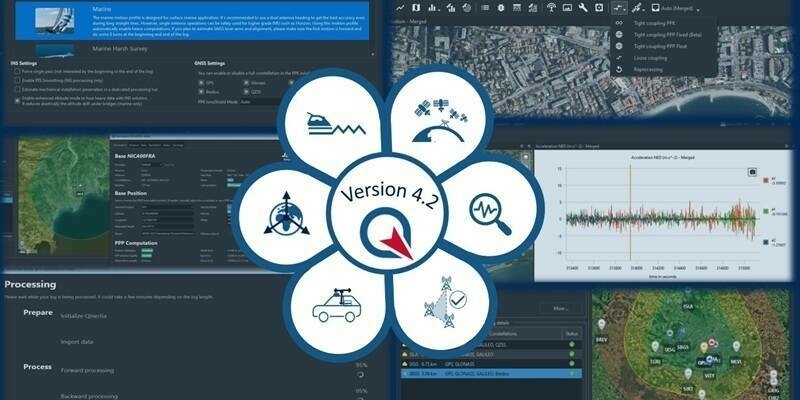Sally Wannop, User Relation Manager, said: "This much anticipated release offers current and prospective users opportunities for exciting applications based on EUMETSAT’s integrated marine data stream. The Copernicus Sentinel-3 data truly offer a new view of our global oceans.”
OCEAN COLOUR DATA — MONITORING THE HEALTH OF OUR PLANET
Ocean Colour data can be used for a wide variety of purposes. They can help to track and forecast harmful algal blooms, which can endanger humans, marine/freshwater life and aquaculture. They also support the monitoring of coastal water quality, by tracking sediment transports.
Ocean colour data are also of a truly global importance as they help monitor climate change: ocean colour is one of the so-called Essential Climate Variables (ECV) listed by the World Meteorological Organization that help detect biological activity in the ocean’s surface layer. In addition, phytoplankton take up carbon dioxide (CO2) during photosynthesis, making them important carbon sinks. Alternatively, ocean colour data can be used to monitor the annual global uptake of CO2 by phytoplankton on a global scale.
Observations of ocean colour support studies of the Earth system, for instance through monitoring El Niño/La Niña events and their impacts on ocean living ecosystems.
And finally, ocean colour data can aid reporting obligations of the European Union's legislation within Marine Strategy Framework Directive and Water Framework Directive, the goal of which to achieve or maintain Good Environmental Status of the seas by the year 2020.
Ewa Kwiatkowska, Remote Sensing Scientist at EUMETSAT said: “The recent International Ocean Colour Science in Lisbon has clearly demonstrated how eagerly these data have been awaited by the international user community. Their outstanding quality is a result of the feedback provided by experts throughout the commissioning phase and coordinated efforts from EUMETSAT and the ESA mission performance centre.”
SEA SURFACE TEMPERATURE DATA — TAMING THE IMPACT OF STORMS
The SLSTR instrument measures the intensity of radiant energy emitted from land and sea surfaces in nine spectral bands, including visible and infrared channels. Measuring sea surface temperature is important as the ocean plays an important role in shaping our climate and weather patterns.
In particular, sea surface temperature data is used as input for weather and ocean forecasting, to observe and monitor ocean current systems and ocean fronts, eddies, upwelling areas and much more.
Because of the importance of sea surface temperature to the global heat budget it is also monitored as an Essential Cimate Variable.
These data are also used to improve understanding of the ocean surface layer, upper ocean variability, energy transfer, air-sea interactions, and the impact of changes in the temperature of the ocean surface over the course of the day and changes between the temperature at the ocean surface and the depths below.
Like OLCI data they are used to help manage marine ecosystems, this time for identifying frontal areas bringing in large shoals of fish or monitoring coral bleaching events, and for travel and tourism.
Anne O’Carroll, Remote Sensing Scientist at EUMETSAT said: “Many teams in Europe have been collaborating together, over an intensive period of time, towards achieving the best possible data of sea surface temperature from SLSTR. It is exciting for all involved that these high quality sea surface temperature data will now be available to all users.
EASY ACCESS TO SENTINEL-3 DATA
All data from OLCI and SLSTR are easily accessible through a number of sources:
- Via the EUMETCast flexible dissemination system.
- Via the Copernicus Online Data Access (CODA), an online rolling archive.
- By ordering from the EUMETSAT Data Centre.
These data from the optical instruments are available in near-real-time (NRT) formats (i.e. within three hours of sensing) and also as non-time-critical (NTC) products, with a requirement to be available within one month of sensing but typically delivered within 48 hours.
The OLCI L2 Ocean Colour data in Reduced Resolution will be distributed on EUMETCast Channel E1H-S3A-03 (PID: 600, Multicast address: 224.223.223.12:5011).
Example filename: S3A_OL_2_WRR____20170621T141102_20170621T145527_20170621T165407_2665_019_096______MAR_O_NR_002.SEN3.tar
The SLSTR L2 SST data will be distributed on EUMETCast Channel E1H-S3A-04 (PID: 600, Multicast address: 224.223.223.12:5012).
Example filename: S3A_SL_2_WST____20170621T153013_20170621T153212_20170621T165301_0118_019_096_5939_MAR_O_NR_002.SEN3.tar
To receive these products via EUMETCast, users should register via our Earth Observation Portal (EOP).
Images: Zoomed in OLCI imagery of bloom in the Baltic Sea, 20 July 2016 03:00 UTC, Sentinel-3 OLCI Level-2 Algal Pigment Concentration, Sentinel-3 SLSTR Sea Surface Temperature Level-2 Ensemble Mean, 15-19 June 2017
Subscribe to our newsletter
Stay updated on the latest technology, innovation product arrivals and exciting offers to your inbox.
Newsletter

